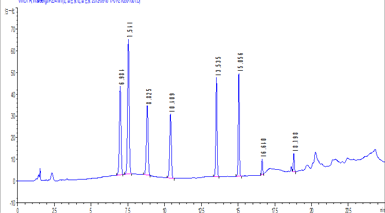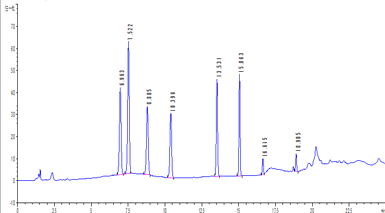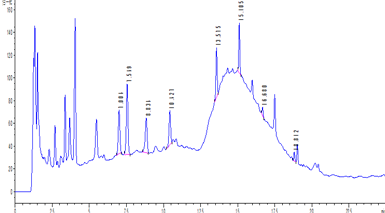 Xinhong
Xinhong  Amaranth
Amaranth  Indigo
Indigo  Carmine
Carmine  Sunset yellow
Sunset yellow  Temptation red
Temptation red  Bright blue
Bright blue 
two. Purpose
Refer to "Determination of Synthetic Colorants in Foods" (GB / T5009.35-2003) to establish an SPE-HPLC detection method for synthetic colorants in red wine.
3. Experimental method
3.1 Experimental reagents
l acetic acid;
l methanol;
l Ammonium acetate solution (0.02mol / L): Weigh 1.54g ammonium acetate, add water to dissolve and dilute to 1000mL;
l Ammonia solution: measure 2ml of ammonia water, add water to 100mL, mix well;
l Methanol / formic acid (6 + 4) solution: measure 60mL of methanol and 40mL of formic acid, mix well;
l Citric acid solution: Weigh 20g citric acid, add water to 100mL to dissolve, mix well;
l Anhydrous ethanol-ammonia solution-water: Measure 70mL of absolute ethanol, 20mL of ammonia solution and 10mL of water, and mix well;
l Water (PH = 6.0): water plus citric acid solution to adjust PH = 6.0;
l Water (PH = 4.0): water plus citric acid solution to adjust PH = 4.0;
l Water: ultrapure water
l Synthetic colorant stock solution: Each 1.0mL contains an aqueous solution of lemon yellow, new red, amaranth, indigo, carmine, sunset yellow, brilliant blue 0.5mg, temptation red 0.1mg;
l Synthetic colorant use solution: The above synthetic colorant stock solution is diluted stepwise into an aqueous solution containing 5 μg each of lemon yellow, new red, amaranth, indigo, carmine, sunset yellow, and brilliant blue in 1.0 mL, and 1 μg of lure red;
3.2. Experimental consumables
Name Specifications Order No. Venusil® XBP C18 5μm, 100A, 4.6 * 150mm VX951505-0 protection column 4.6 * 10mm, 4 / pk VX950105-0 protection column sleeve for 4.6 * 10mm protection column CH-100 Cleanert® JAX 1g / 6ml, 30 / box JXA0006 Hydrophilic PTFE 0.45um, 13mm, 100 / bag AS0813453.3. Sample processing
Take 20ml of sample (red wine of a certain brand), add 1.0mL of synthetic colorant mixed standard solution, mix well, adjust the pH to about 6.0 with 10% ammonia water, pass all the samples through Cleanert® JAX column, and use water (PH = 4.0), Rinse with 6 mL of methanol / acid (6 + 4) solution, then rinse with 10 mL of water, elute with 6 mL of ethanol-ammonia solution-water (7 + 2 + 1), collect the eluent and evaporate to dryness in a 50 ° C water bath , Add water to bring the volume to 1.0 mL, filter through a 0.45 μm filter membrane, and wait for the test.
3.4 Liquid chromatography conditions
Column: Venusil® XBP C18, 5μm; 4.6 * 150mm;
Mobile phase: A: 0.02mol / L ammonium acetate solution (acetic acid adjusts pH = 4);
B: methanol
Flow rate: 1.0mL / min;
Injection volume: 20μL;
Wavelength: 254nm;
gradient:
Time A% B% 0 95 5 10 80 20 18 40 60 25 40 60 25.01 95 5 40 95 5four. Experimental results
Table 2. Recovery data of mixed standard with 5ppm added
V. Experimental conclusion
The experimental results show that Cleanert® JAX cartridges and Venusil® XBP C18 liquid chromatography columns can be used for the detection of synthetic colorants in red wine. This method is fast and accurate.
Six, matters needing attention
l The red wine sample is weakly acidic, and its pH value should be adjusted to about 6 before loading, to ensure that the small column can adsorb the synthetic colorant well;
l If the alcohol content of the sample is too high, it is recommended to remove alcohol from the sample before loading;
l During the purification of the SPE cartridge, attention should be paid to the control of the flow rate, which is recommended to be controlled at about 1mL / min;
l After the eluent is blown and reconstituted with nitrogen, it should be filtered with an aqueous filter to prevent the loss of the sample due to the adsorption of the filter. It is recommended to use the Agela Hydrophilic PTFE filter.
appendix:

Figure 1 5ppm mixed standard solution

Figure 2 5ppm mixed standard through column 1

Figure 3 5ppm mixed standard passing through column 2

Figure 4 blank map of red wine

Figure 5 5ppm matrix spike 1

Figure 6 5ppm matrix spike 2
A training chair is a seat designed specifically for activities such as training and meetings. It has the characteristics of comfort, durability, and ease of movement, which can meet the needs of different groups of people. Training chairs can be classified into various categories based on material, structure, function, and other aspects. Below will be a brief introduction to the classification of training chairs.
1. Material classification
The materials of the training chair mainly include metal, plastic, and fabric. Metal training chairs typically have strong stability and durability, making them suitable for long-term meetings or training activities. The training chair made of plastic material has the characteristics of lightweight and easy to clean, making it easy to arrange the meeting site at any time and suitable for use in multifunctional halls and other places. The training chair made of fabric has a comfortable sitting experience and good breathability, making it suitable for long-term meetings or training activities.
2. Structural classification
The structure of training chairs mainly includes single chairs, linked chairs, and foldable chairs. Single chairs are the most common training chairs, with each seat being independent and adjustable as needed. Chainage refers to the connection of multiple seats together, usually in the form of one or more rows, suitable for use in large training venues. Stackable chairs are training chairs that can be folded and stacked, saving space and facilitating storage and handling.
3. Functional classification
The main functions of the training chair are adjustable, rotatable, foldable, and storable. The adjustable training chair can adjust the height and angle according to personal needs, providing a more comfortable sitting posture. The rotatable training chair can rotate 360 degrees, facilitating communication and interaction with people around it. The foldable training chair can be conveniently stored and transported, making it suitable for use in multifunctional halls and other places. The training chair that can store items is designed with storage space below or behind the chair, making it convenient to store items such as stationery and documents.
In summary, the classification of training chairs mainly includes material classification, structural classification, functional classification, etc. Choosing a suitable training chair can provide a better user experience and improve the effectiveness of training and meetings.
Meeting Chair,,Foldable Chair,Customized Chair
Foshan Shengshi Zhihui Technology Co., Ltd. , https://www.sshotelfurniture.com